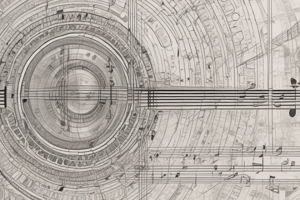Podcast
Questions and Answers
Which instrument produces sound primarily through vibrating strings?
Which instrument produces sound primarily through vibrating strings?
- Flute
- Trumpet
- Drum
- Violin (correct)
What are harmonics in the context of sound production?
What are harmonics in the context of sound production?
- Integer multiples of the fundamental frequency (correct)
- Non-integer multiples of a sound's fundamental frequency
- The lowest frequency in a sound wave
- Random frequencies that disrupt sound
Which of the following vocal registers does NOT typically affect vocal timbre?
Which of the following vocal registers does NOT typically affect vocal timbre?
- Breath control (correct)
- Falsetto
- Chest voice
- Head voice
What defines a polyphonic texture in music?
What defines a polyphonic texture in music?
Which of the following factors influences tone color in music?
Which of the following factors influences tone color in music?
Which of the following best describes inharmonics?
Which of the following best describes inharmonics?
What characteristic typically does NOT affect the timbre of the human voice?
What characteristic typically does NOT affect the timbre of the human voice?
Which term best describes the main melody supported by harmony?
Which term best describes the main melody supported by harmony?
Flashcards are hidden until you start studying
Study Notes
Music Timbre
Instrument Classification
- Families of Instruments:
- String Instruments: Produce sound via vibrating strings (e.g., violin, cello).
- Woodwind Instruments: Sound made by air vibrating through a tube (e.g., flute, clarinet).
- Brass Instruments: Sound is produced by lip vibrations against a mouthpiece (e.g., trumpet, trombone).
- Percussion Instruments: Produce sound when struck, shaken, or scraped (e.g., drums, cymbals).
- Classification Criteria: Instruments can be categorized based on:
- Method of sound production (e.g., vibrating strings vs. vibrating air).
- Material of construction (wood, metal, plastic).
- Size and shape, affecting resonance and timbre.
Harmonic Content
- Fundamental Frequency: The lowest frequency of a sound; perceived as the pitch.
- Overtones: Higher frequencies above the fundamental; contribute to the richness and complexity of timbre.
- Harmonics vs. Inharmonics:
- Harmonics: Integer multiples of the fundamental frequency.
- Inharmonics: Frequencies that are not whole number multiples, resulting in a unique sound character.
Voice Timbre
- Human Voice Characteristics:
- Vocal Registers: Distinct ranges (e.g., chest voice, head voice, falsetto) affecting timbre.
- Formant Frequencies: Resonant frequencies altered by shape of vocal tract, influencing quality of sound.
- Articulation and Enunciation: Affecting how sounds are produced, altering the perceived timbre of spoken or sung words.
Sound Texture
- Monophonic: Single melodic line without accompaniment.
- Homophonic: Main melody supported by chords or harmony.
- Polyphonic: Multiple independent melodies occurring simultaneously, creating complex textures.
- Texture Variations: Thickness or thinness of music results from the number of instruments and their interactions.
Tone Color
- Definition: Refers to the quality of sound that distinguishes different types of sound production.
- Components Influencing Tone Color:
- Attack and Decay: Initial sound onset and how it diminishes over time.
- Dynamics: Variation in loudness affecting perceived color.
- Use of Effects: Reverb, distortion, and modulation can alter the original timbre.
Instrument Classification
- String Instruments create sound via vibrating strings. Examples include the violin and cello.
- Woodwind Instruments produce sound by air vibrating through a tube. Examples include the flute and clarinet.
- Brass Instruments use lip vibrations against a mouthpiece to generate sound. Examples include the trumpet and trombone.
- Percussion Instruments produce sound when struck, shaken, or scraped. Examples include drums and cymbals.
- Instrument classification considers factors such as method of sound production, material of construction, and size and shape, which affect resonance and timbre.
Harmonic Content
- Fundamental Frequency is the lowest frequency of a sound, perceived as the pitch.
- Overtones are higher frequencies above the fundamental that contribute to timbre's richness and complexity.
- Harmonics are integer multiples of the fundamental frequency, while Inharmonics are not whole number multiples, resulting in distinct sound characteristics.
Voice Timbre
- Vocal Registers, like chest voice, head voice, and falsetto, impact timbre.
- Formant Frequencies are resonant frequencies influenced by the vocal tract's shape, affecting sound quality.
- Articulation and Enunciation influence how sounds are produced, altering the perceived timbre of spoken or sung words.
Sound Texture
- Monophonic music consists of a single melodic line without accompaniment.
- Homophonic music features a main melody supported by chords or harmony.
- Polyphonic music involves multiple independent melodies occurring simultaneously, creating complex textures.
- Texture Variations refer to the thickness or thinness of music, influenced by the number of instruments and their interactions.
Tone Color
- Tone Color describes the distinctive sound quality of various sound sources.
- Factors influencing tone color include:
- Attack and Decay: The initial sound onset and how it diminishes over time.
- Dynamics: Variations in loudness affect perceived color.
- Use of Effects: Reverb, distortion, and modulation can alter the original timbre.
Studying That Suits You
Use AI to generate personalized quizzes and flashcards to suit your learning preferences.




